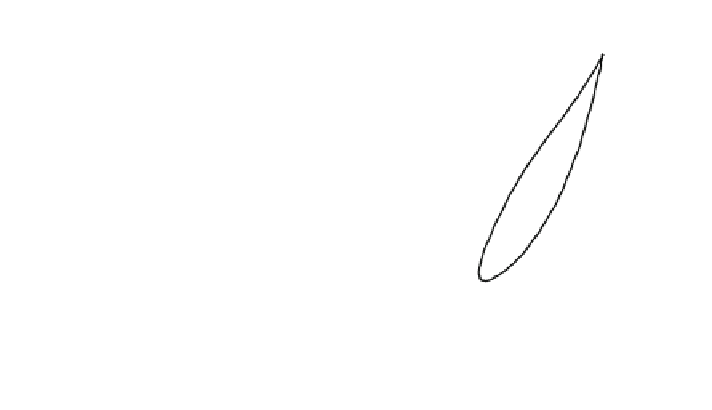Environmental Engineering Reference
In-Depth Information
Fig. 6.6 Blade element at
radius r on a stationary blade
wind
direction
1-a
U
T
a
'
φ
θ
P
α
direction
of
rotation
6.2 Estimating the Starting Torque
Figure
6.6
shows the velocity diagram for a stationary blade element which can be
compared to that for a rotating, power producing element in Fig.
3.2
. Both a and a
0
are likely to be small on a stationary blade, so the velocity vector is not to scale. It
is known from the previous two chapters that typical twist angles are around 20
near the hub and zero near the tip, so the angles of attack on a stationary blade are
high and in the range discussed in
Sect. 4.4
. Thus the aerodynamic torque on a
stationary blade is likely to be small and the resistive torque, as documented in
Fig.
1.12
, often significant.
The term ''rotational'' inflow factor for a
0
is not appropriate for a stationary
blade so it will be referred to as the ''circumferential'' inflow factor. Equation
3.11
for the torque generated on each blade element can be written as
dQ
dr
¼
1
2
NqU
T
cC
l
sin /
C
d
cos /
ð
Þ
r
ð
6
:
1
Þ
Assuming that both a and a
0
are small:
/
p
=
2
;
a
p
=
2
h
P
;
and
sin a
cos h
P
ð
6
:
2
Þ
In words: only the lift generates torque on a stationary blade. In order to determine
typical values of the starting torque, Q
s
,Eq.
4.6
with A = 1 gives, after some easy
manipulation,
dQ
s
dr
¼
1
2
NqU
T
cr sin
ð
2h
q
Þ
ð
6
:
3
Þ
Balancing (
6.3
) against the angular momentum in the wake, from Eq. (3.5),
leads to


















Search WWH ::

Custom Search